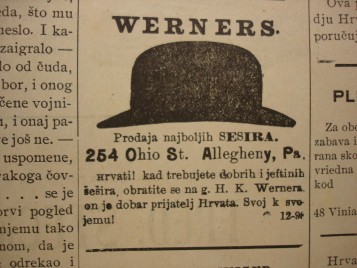Presentation in Boston, November 2011

»Advertising Difference: Bodies, Nostalgia, and Migrant Facilities in the US South Slav Press«
Session ›Consuming Diasporas: Migration and Consumption from a Transnational Perspective‹, 36th Annual Meeting of the Social Science History Association, Boston 17.–20. November 2011.
Abstract: This paper will describe how newspaper ads in US South Slav periodicals from the 1890s to the 1930s can be used to analyze the changes in practices of culture and consumption of migrants from the Austro-Hungarian monarchy. Slovene, Croat, Serb and Bosnian migrants were relatively late arrivals in the US and also their national identity projects and newspaper discourses were not as developed as those of other Central European populations. Their migration patterns to the US were dominated by short term male rural-urban migrants. Nevertheless, US South Slav newspapers had a boom in the 1890s. After WWI, the South Slav ethnic press persisted longer than other ethnic presses. With newspaper ads we can describe this history as a history of the everyday. Gender, class and ethnicity, as negotiated through commodities, have left traces in the commercial sections of the ethnic press. This paper will discuss how South Slav migrants were entangled in the changing gender and body politics in the US, how the changing marriage market and generational shifts were connected with this, and how ethnic business turned from facilitating migration to commodifying nostalgia for the homeland vis-à-vis the pressure of larger US corporations.